
views
X
Research source
If you want to change the way you play guitar or test out a new sound, you can learn to use a guitar slide.
Choosing the Right Equipment for Sliding

Pick your slide. There are many different slides you can choose from. Many musicians make slides out of common every day objects, such as glass bottle tops, metal piping, or glass medicine bottles. The easier option for those just starting to use a guitar slide is to buy a new one from a music store. The two most common types are glass and metal slides. Glass slides are typically lighter and create a airy, sharp sound. Metal slides produce a deeper, warmer, and louder tone but are heavier on your finger. Different slides will sounds different on specific guitars, Before you commit to a slide, test it on your guitar to make sure it creates the sound you want.
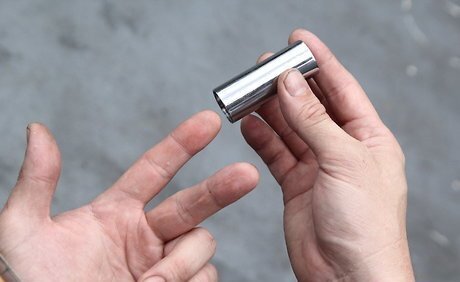
Choose which finger to put the slide on. There are three fingers you can wear your slide on, your middle, ring, or pinky finger. The finger you choose will vary the sound you get from the slide as well as the mobility of your remaining fingers. Your middle finger will need a larger slide since your middle finger is bigger than your others. Using this finger will produce a hearty tone, but you will not be able to use your other fingers to play notes or mute the strings. This means that you will only be able to produce the slide sound. Your ring (or fourth) finger will need a smaller slide than the one for your middle finger. This slide covers the whole fretboard and helps produce a full sound. You can mute the other keys with your index and middle fingers, which allows you to play normal notes as well. Your pinky finger will need a much smaller slide than your other fingers. Your finger will not cover the whole fretboard, but your can use your other three fingers to play normal notes and mute the strings while you play.

Use the right guitar. The best guitar to use for sliding is one with higher action. This means you need to find a guitar that has more room between the fretboard and the strings. If you converting one of your guitars to use for sliding, you can leave your guitar's action high. If you are switching back and forth between sliding and normal playing, you should adjust your action to a higher setting before you try to slide. This prevents extra noise reverberation between the strings and the fretboard as you slide. If you are using an electric guitar (which typically has low action), you will have better luck with a glass slide.
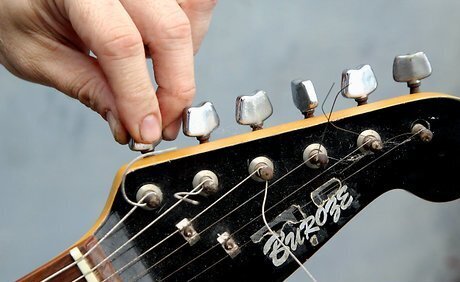
Tune your guitar for sliding. For sliding, you should have open tuning on your guitar. This means that the open string notes should belong to major chords. This kind of tuning makes it great for accompanying other instruments. Some common open tunings are D-G-D-G-B-D, E-B-E-G#-B-E, and D-A-D-F#-A-D. If open tuning is unfamiliar to you, you can use a regular tuned guitar. You just may not be able to get the same kind of sound out of your guitar from sliding. You can use online resources to help you open tune your guitar. You can also ask someone else to help you get it tuned correctly.
Learning to Use a Guitar Slide
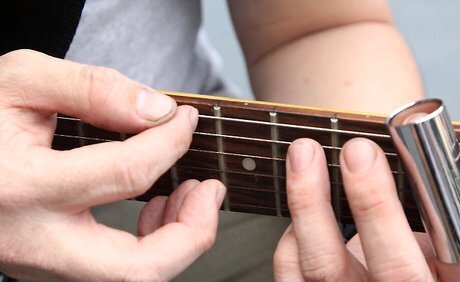
Mute the strings above your slide. In order for you to make the right sounds with your slide, you need to learn to mute the strings above where your sliding. This will keep the strings from unwanted vibrations and keep them from producing unwanted sounds. To do this, gently press your fingers on the strings. Use just enough pressure to keep the strings from making unnecessary noises as they vibrate.
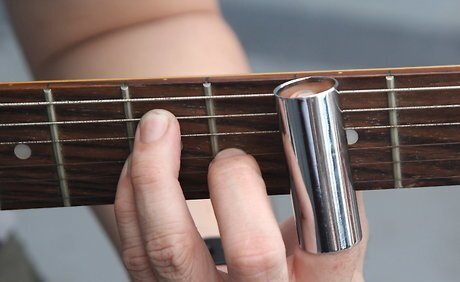
Press the slide directly above a fret. To play your slide correctly, you need to make sure you are pressing it in the right place. You should not press the string under or above the fret because the note will sound flat. You should also not press the string into the fretboard. Even if your eyes say that you are directly above the fret, listen to the note. If it sounds flat or wrong in any way, move your slide up and down until it makes the right note.

Slide into the notes. To start learning to slide, pick a note on your guitar. Muting the other strings with your non-slide fingers, press gently with the slide and then move it up and down the strings to make the sliding sound. You can start slow to get a feel for the different technique of playing and motions needed to play with the slide on. If you are using the slide on your middle finger, you will not be able to mute the strings. Just apply gently enough to get the sound you want. Try playing songs you are familiar with using your slide to get used to the different feel of the technique.
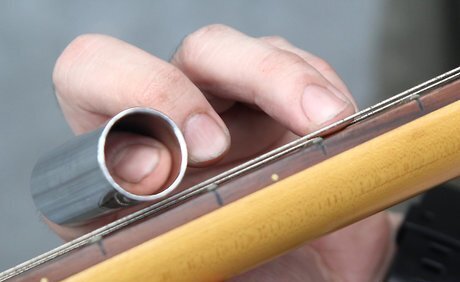
Use gentle pressure. When you use a slide, you should not press too hard on the strings. This will make the strings touch the fretboard, which will cause your guitar to make strange, unpleasant sounds. Move your hand up and down to gauge how hard you are pressing. If it's hard to move the slide, you should lighten your pressure. The more you move your hand around, the better feel you will have for the strings.
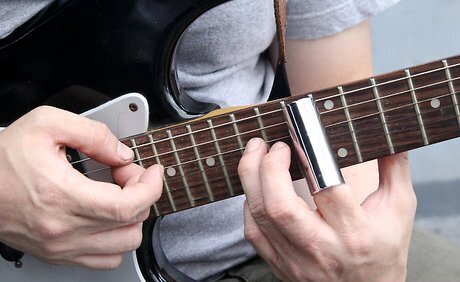
Mute the strings between notes. As you play note after note, the strings will continue to reverberate. If you slide up the string to your next note, all the notes in between will play as well. To avoid this, mute the strings between different notes using your other hand. You can use the finger that you are picking with or the heel of your hand to help mute the strings. Sliding between the notes is part of the slide sound. However, if you slide between the notes you play, the sound can get overwhelming or redundant. Practice different songs to decide when to slide and when you should mute the strings.
Using Additional Sliding Techniques

Try out different sounds. There are different sounds you can make while using a slide. You can try different sliding techniques to create different slide sounds by starting in different places, playing different notes, or changing hand speeds. For example, if you want a bluesy sound, start below the fret and slid up to the fret. This may be uncomfortable because you are conditioned to aim just under the fret. You can also use vibrato to get a different kind of sound from sliding. However, don’t try to move the string up and down as you would with normal vibrato because this won't work with the slide on. Instead, get the same effect by moving the slide back and forth slightly.
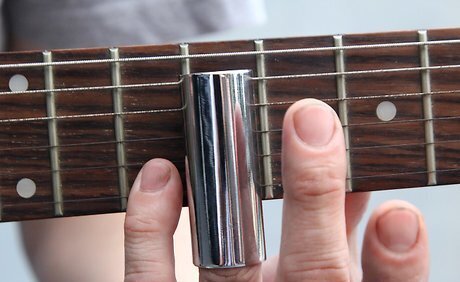
Keep your slide parallel to the frets. In order for the slide technique to sound right, your slide should be directly parallel to the frets as you play. Think about the slide as a replacement for the fret on your guitar. There are advanced sliding techniques where you can learn to angle your slide. However, when you are beginning, keep it centered directly above the fret until you are completely comfortable.
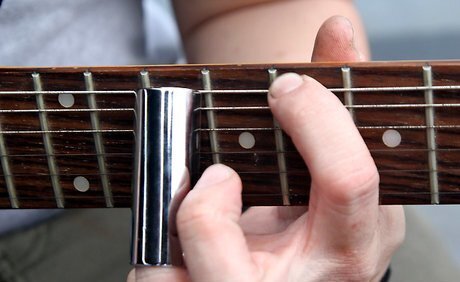
Shift your hand on higher strings. There are certain notes you will play that will cause your hand positioning to change. For instance, if you are playing notes on the higher two strings, shift the slide up off the bottom strings so it only hits the top strings. If it hits the lower strings, it may cause clatters and bumps that you don’t want, even if you are muting those strings. When you play the lower strings, the slide will be on all the strings. Just be sure to mute the higher strings very well with your index finger.












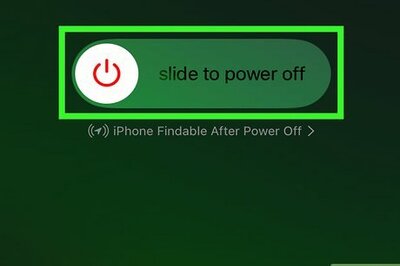






Comments
0 comment